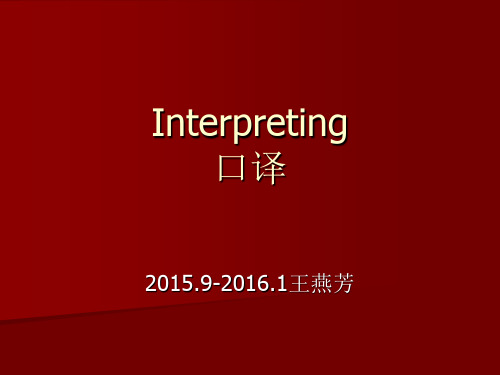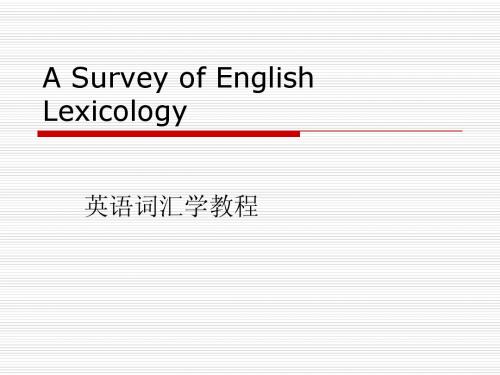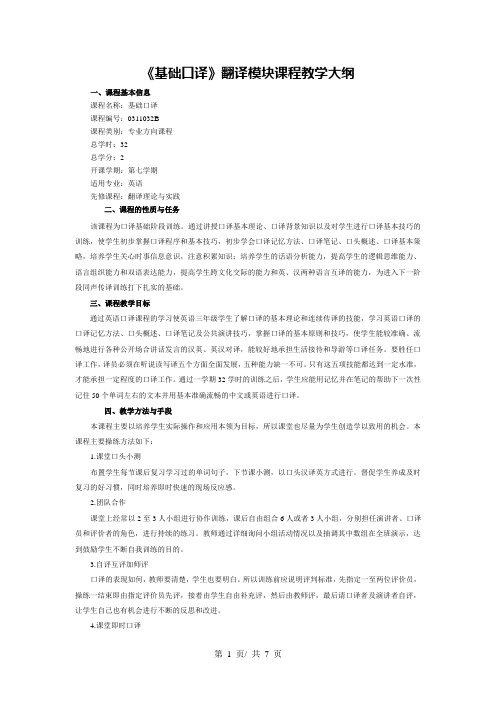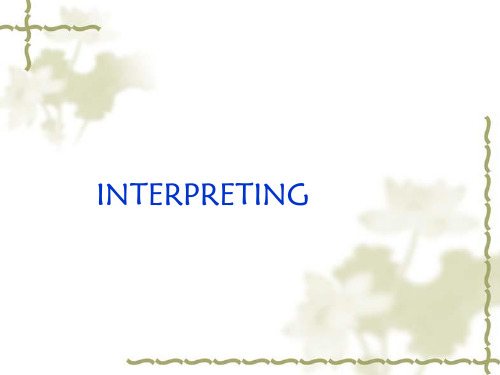英语口译基础教程UnitIntroduction
interpretation Lesson[1]精品PPT课件
![interpretation Lesson[1]精品PPT课件](https://img.taocdn.com/s3/m/67d4687e10a6f524ccbf85a1.png)
表达一般比理解要难些。联合国聘用语文专业人员有一 条规定:翻译审校要一律以母语为译入语言 。因此,
在国际翻译界, 从事翻译工作的人大多将外语翻译成本 国语言。
3.但是由于国际上懂中文、并懂到能够担任翻译的外国 人还是不多,中国翻译在大多数情况下必须进行双向对 译。
3。记录,或者叫做暂存,是指将感知到的语码信息暂时储存下来。口译的信息 记录采用两种形式,一种是以 “ 脑记 ”为主, 一种是以 “ 笔记 ” 主。译员 所记录的内容主要是信息的概念、主题、论点、情节、要点、逻辑关系、数 量关系等。
4.编码是指将来源语的信息解码后, 赋以目标语的表达形式。口译的编码技 巧与笔译的编码技巧相仿, 所不同的是,口译要求快速流利, 所以无法像笔译那 样有时间斟酌字眼, 处理疑难杂症,追求目标语的 " 雅致 " 。
5.表达是指译员将以目标语编码后的信息通过口头表达的方式传译出来。口 译表达无需译员具备伶牙俐齿、口若悬河、能言善辩的演说才能,但口齿清楚、 吐字干脆、音调准确、择词得当、语句通顺、表达流畅却是一名职业译员必
备的条件。
口译的类型 The Categorical Classification of
口译类型的划分有三种不同的方法, 即 " 形式分类法 " 、 " 方向分类法 " 和 " 任 务分类法 " 三种。
II.口译的定义
The Definition of Interpretation
1.口译是一种通过口头表达形式,将所听到 ( 间或读到 ) 的信息准确而又快速地由一种语言转换成另一种语言, 进而达到传递与交流信息之目的的交际行为,是人类在 跨文化、跨民族交往活动中所依赖的一种基本的语言 交际工具。 2.从事上述口译工作的人叫做译员。在相当长的时期 里以口译为职业的人叫做职业译员。 3.译员必须是掌握两种语言 ( 或两种以上语言 ) 的语 言知识和语言能力的双语人。具有双语能力的人可以 通过系统学习、强化训练和勇于实践,进而较好地掌握 口译知识和技能,成为一名合格的职业译员。
Unit 1 Interpreting 口译概况

心动不如行动!
口译的培训模式
同声传译模式: SI=L + M + P + C 同声传译(Simultaneous Interpreting)= 听力与分析(Listening and Analysis)+ 短期 记忆(Short-term memory effort) + 言语传 达(Speech Production)
Interpreting 口译
2015.9-2016.1王燕芳
Interpreting 口译
商务英语口译(黄敏) VOA慢速英语 VOA标准英语 CN理论、口译背景知识以及对学 生进行口译基本技巧的训练,使学生初步掌握口 译程序和基本技巧,初步学会口译记忆方法、口 译笔记、口头概述、公众演讲等基本技巧和口译 基本策略,培养学生关心时事的信息意识,积累 知识,掌握文献检索、资料查询的基本方法;培 养学生的话语分析能力,提高学生的逻辑思维能 力、语言组织能力和双语表达能力,提高学生跨 文化交际的能力和英、汉两种语言互译的能力。
难易程度 证书有效期
初级:三级 > 三级 > 中级 中级:二级 > 二级 > 高级 高级:一级 > 一级 > 无 每3年重新注册 登记一次,一次 注册有效期3年
暂无
暂无
口译的发展前景
在“非全日制就业人员工资指导价位”表 中列出的54种行业里,同声传译以每小时 2000元人民币的价格拔得头筹。 同声传译价目表中,英语类1天1.2万~2.1 万元人民币,非英语类是1.8万元人民币。 业内人士称,平均每星期做两次同声翻译, 一年平均50多万RMB。 交传一天的平均工资在3000-6000RMB.
口译与笔译的异同
第1单元 口译简介Essentials of Interpreting - 副本 - 副本 - 副本

What is the so-called “key word” in a sentence?
“Key word”should be the words that convey speaker's main ideas and intentions. It reveals speaker's focus and emphasis in a speech.
Definition of Interpreting (ii)
Interpretation means an extempore oral reproduction, in one language, of what is said in another language. It cannot be viewed as a merely linguistic undertaking, but should be regarded as an aspect of a larger domain, namely, that of communication. (zhong shukong, 1999)
From which four perspectives can we identify key words in a sentence to get the key information?
A key word can be noticed from its part of speech, syntactic structure, semantic analysis, and tones.
Basic Requirements for Interpreters (ⅱ)
Non-linguistic knowledge
实用口译unit 1 An Introduction to the course of interpreting

2)根据空间工作模式,可分为现场口译和远程口译 现场口译:live interpreting 当事双方和译员同时在场 远程口译:remote interpreting 当事双方和译员不在一地: 电话口译、远程视频口译等。 3)根据活动场合和主题,可分为: 会议口译 conference interpreting 陪同口译 escort interpreting 外交口译 diplomatic interpreting 商务口译 business interpreting 媒体口译 media interpreting 社区口译 community interpreting 导游口译 guide interpreting 医学口译 medical interpreting国外有资格认证 法庭/法律口译 court/legal/judicial interpreting 国外有资格 认证 法庭译员被称为宣誓译员 sworn interpreteurse
1. How to improve your memory? 2. How to take notes? 3. How to decode meaning and transfer it? 4. How to interpret numbers? 5. How to interpret long sentences? 6. What are the coping tactics?
3. Classification of Interpreting
1)根据时间工作模式,可分为交替传译和同声传译 交替传译:consecutive interpreting 简称CI 也称连续口译/传译、即席口译/传译、逐步口译(台湾用 语) 简称“交传”或“连传” 讲话人说一段,译员翻译一段,然后循环往复、交替进行 3分钟以上即可称为长交传 交替传译常用于新闻发布会、外事会见、商务谈判、户 外活动等 同声传译:simultaneous interpreting 简称 SI 又称同步口译、即时传译(港台用语) 简称“同传” 讲话人的“说”与译员的“译”几乎同时进行。
商务口译

Introduction(绪论)Unit 1ProtocoI Routine(迎来送往)Long—term Preparation(长期准备)Unit 2Ceremonial Address(礼仪致辞)Short—term Preparation(短期准备)Unit 3Dinner Party(晚宴聚会)Active Listening(积极听入)Unit 4Business TraveI(商务旅行)Discourse Analyzing(语篇分析)Unit 5Business Interview(商务访谈)Note Taking(Ⅰ)(口译笔记1)Unit 6Business Advertisements(商务广告)Note Taking(Ⅱ)(口译笔记2)Unit 7Business Presentations(商务陈述)Note Taking(Ⅲ)(口译笔记3)Unit 8Enterprise Introduction(企业介绍)Retelling(复述)Unit 9Enterprise Culture(企业文化)Public Speaking(公开演讲)Unit 10Marketing & Promotion(市场营销)Paraphrasing(一句多译)Unit 11Business Negotiation(商务谈判)Figures Interpreting (数字口译)Unit 12Business Meeting(商务会议)Idioms Interpreting(成语口译)Unit 13Investment&Profits(投资利润)Fuzzy Interpretation(Ⅰ)(模糊表达1)Unit 14Business Policy(商务政策)Fuzzy Interpretation(Ⅱ)(模糊表达2)Unit 15International Exhibition(国际会展)Fuzzy Interpretation(Ⅲ)(模糊表达3)Unit 16Public Relations(公共关系)Sight interpreting《视译练习)Unit 17Business Strategy(商务策略)Shadowing(影子跟读)Unit 18Transportation & Logistics(交通物流)Quality Assessment (质量评估)U n i t F o u rB u s i n e s s T r a v e lUnit Objectives (单元目标)After reading this unit, you shouldunderstand the ways to identify the main ideas of the source text.find ways to improve your interpreting skills and performance.master the basic words and expressions about business travel.know some cultural background knowledge about business travel.reparingI. Interpreting Skills (口译技能)Read the following presentation about discourse analysis and try tounderstand the four speech types and know how to identify the main ideasof the source text. Then complete the following task:1. Listen to the passage, “My first day in New York”, and answer thefollowing questions:1). When did the author first arrive in the US2). What did the author do on the way to his hotel3). Where did the author get something to eat after his friend had left4). Why couldn’t he have what he really wanted at the restaurant5). What did the author do after dinner2. Listen to the passage again and try to catch more details, and thenretell the story in your own words.Decoding Training (II): Discourse Analysis(语篇分析)Interpreting is to “understand and make understood”. To interpret the speech, one must first understand the message of the speech. However, comprehension(理解)of the source discourse goes beyond the simple recognition of words and linguistic structures. The interpreter shall make an analysis of the source discourse. More importantly, the interpreter shall identify(识别)the speech type and know how to identify the main ideas of the original speeches.Identification of the Speech TypesSpeeches are diversified serving different occasions and purposes. It will be of great help to the interpreters if they know the speaker’s style. In most cases, speechesare prepared beforehand. Therefore, a study of the different types of writing helps an interpreter identify the main idea of a given speech. Following are the basic types of writing.1. Descriptive WritingDescriptive(描述性的)writing involves a great deal of detailed information. A descriptive discussion aimed at providing details of an event, a scene, a procedure, or a situation.This speech type demands a thorough background investigation of the speaker and the relevant situation by the interpreter.2. Narrative WritingNarrative(叙述性的)writing focuses on the development of events. There is no doubt that the interpreter should be very sensitive to dates, time phrases, and verb tenses when a narrative speech is dealt with.3. Expositive WritingExpositive(说明性的)writing deals with its subject matter in such orders as chronological, spatial, comparison, and definition. It would be to the advantage of the interpreter to conduct a background investigation of the speaker and the situation, for that would provide the interpreter with not only the necessary glossary but also the speaker’s standpoint(立场).4. Persuasive WritingPersuasive(劝说性的)writers always want to make their arguments clear, strong and convincing. When the purpose is to convince, writers of persuasive writing mainly employ two techniques -- induction(归纳)and deduction(推论). Inductive writing starts with specific examples or points to draw a general conclusion, while deductive writing illustrates its thesis at first and then supports and reinforces the thesis through specific examples or subordinate ideas.Identification of the Main IdeasIn the context of interpreting, the main ideas of the source speech can be identified at the sentence level and at the discourse level. Priority should always be attached to identifying the main idea at the sentence level. We argue that identification of main ideas be done on the basis of sentences. Training in identifying the main ideas in interpreting should naturally take place first at the sentence level.1. Sentence LevelThe most important task for an interpreter to identify the main ideas at the sentence level is to discern (洞悉) the subject, verb and object (SVO). It is highly significant for the interpreter to catch the SVO of the sentence while listening to the source text, as the SVO usually carries the major information of the sentence. For example, when listening to “The best way to carry money while traveling is to have a major credit card”, the interpreter is expected to catch “The best way is to have a credit card.”If the interpreter is able to catch the SVO of the sentence, he then will produce a complete sentence with the major information in the target language.2. Discourse LevelThere are also some skills an interpreter might employ on different occasions for grasping the gist(要点)of a speech at the discourse level. In a well-organized speech, the speaker usually explains his point in the first few sentences. Therefore, one of the ways to get the main idea of a speech is to attach priority to the beginning of the speech. Secondly, if the interpreter encounters a speech that is inductively constructed, the interpreter should, to the best of their ability, conduct a study of the speaker's background and viewpoints so that they can follow the speaker's logical guidelines.II. Phrase Interpreting (短语口译)Work on the following words and phrases. Interpret them into Chinese andEnglish respectively.A. English to Chinese1. Have a population of…2. Cover an area of…3. Date back to…4. Have a history of…5. Be situated in…6. The gross domestic product7. Dive-in restaurant 8. Quarantine certificate9. Duration of stay 10. Residence permitB. Chinese to English1、日程安排2、旅行路线3、起飞时间4、机场大楼5、候机室6、贵宾室7、问讯处 8、安全检查9、免税店 10、个人物品III. Sentence Interpreting (句子口译)Work on the following sentences. Interpret them into Chinese and Englishrespectively.A. English to Chinese1. I believe you're going out of your way for us.2. Wouldn't you like to spend an extra day or two here3. I'm afraid that won't be possible, much as we'd like to.4. I wonder if it is possible to arrange shopping for us.5. I will keep you posted.B. Chinese to English1. 我特地为你们安排,使你们在北京的逗留愉快。
unit 1 Introduction 英语词汇学教程

What is lexicology?
Lexicology is a branch of linguistics concerned with the study of the vocabulary of a given language. It deals with words, their origin, development, structure, formation, meaning and usage.
The role of vocabulary in the language system
Vocabulary is the building material of the language system. It is one of the three essential elements of language: speech sounds, grammar and vocabulary.
2.1 What Is a Word?
The definition of a word
A word may be defined as a fundamental unit of speech and minimum free form; with a unity of sound and meaning (both lexical and grammatical meaning), capable of performing a given syntactic function. A word is a combination of form (phonological) and meaning (lexical and grammatical) A word acts as a structural unit of a sentence. 词是能独立运用的、最小的、有语义的语言单位。
《基础口译》翻译模块课程教学大纲

《基础口译》翻译模块课程教学大纲一、课程基本信息课程名称:基础口译课程编号:0311032B课程类别:专业方向课程总学时:32总学分:2开课学期:第七学期适用专业:英语先修课程:翻译理论与实践二、课程的性质与任务该课程为口译基础阶段训练。
通过讲授口译基本理论、口译背景知识以及对学生进行口译基本技巧的训练,使学生初步掌握口译程序和基本技巧,初步学会口译记忆方法、口译笔记、口头概述、口译基本策略,培养学生关心时事信息意识,注意积累知识;培养学生的话语分析能力,提高学生的逻辑思维能力、语言组织能力和双语表达能力,提高学生跨文化交际的能力和英、汉两种语言互译的能力,为进入下一阶段同声传译训练打下扎实的基础。
三、课程教学目标通过英语口译课程的学习使英语三年级学生了解口译的基本理论和连续传译的技能,学习英语口译的口译记忆方法、口头概述、口译笔记及公共演讲技巧,掌握口译的基本原则和技巧,使学生能较准确、流畅地进行各种公开场合讲话发言的汉英、英汉对译,能较好地承担生活接待和导游等口译任务。
要胜任口译工作,译员必须在听说读写译五个方面全面发展,五种能力缺一不可。
只有这五项技能都达到一定水准,才能承担一定程度的口译工作。
通过一学期32学时的训练之后,学生应能用记忆并在笔记的帮助下一次性记住50个单词左右的文本并用基本准确流畅的中文或英语进行口译。
四、教学方法与手段本课程主要以培养学生实际操作和应用本领为目标,所以课堂也尽量为学生创造学以致用的机会。
本课程主要操练方法如下:1.课堂口头小测布置学生每节课后复习学习过的单词句子,下节课小测,以口头汉译英方式进行。
督促学生养成及时复习的好习惯,同时培养即时快速的现场反应感。
2.团队合作课堂上经常以2至3人小组进行协作训练,课后自由组合6人或者3人小组,分别担任演讲者、口译员和评价者的角色,进行持续的练习。
教师通过详细询问小组活动情况以及抽调其中数组在全班演示,达到鼓励学生不断自我训练的目的。
英语口译基础教程 1. interpreting course

3) In terms of ways:
单向口译 ( one-way interpretation ) 双向口译 ( two-way interpretation )
A Brief history of conference interpreting as a modern profession
b. Dissimilarities The Other Basic Requirements for Interpreters
(1) Acute hearing (to grasp the meaning) (2)A good command of idioms, slang and proverbs, as well as register & appropriateness. (3)Phonetic competence (accent, intonation, stress and rhythms) & public speaking skills (4) Outstanding memory and note-taking ability (5) psychological competence: quick-witted, calm, resourceful (avoid panic and stage fright)
* Translating: i n p u t → c o m pr e h en s i on → (output)expression → checking
3) In terms of criteria a. Similarities: a faithful reproduction in natural TL. b. Differences:
- 1、下载文档前请自行甄别文档内容的完整性,平台不提供额外的编辑、内容补充、找答案等附加服务。
- 2、"仅部分预览"的文档,不可在线预览部分如存在完整性等问题,可反馈申请退款(可完整预览的文档不适用该条件!)。
- 3、如文档侵犯您的权益,请联系客服反馈,我们会尽快为您处理(人工客服工作时间:9:00-18:30)。
Definition of Interpreting
口译是一种通过口头表达形式,将所听到(间 或读到)的信息准确而又快速地由一种语言转 换成另一种语言,进而达到传递与交流信息之 目的的交际行为,是人类在跨文化、跨民族交 往活动中所依赖的一种基本的语言交际工具。
Differences between interpretation and translation
By ways: one-way interpreting 单向口译 two-way interpreting 双向口译
Types of interpreting
By contents: guide interpreting 导游口译 ceremony interpreting 礼仪口译 information interpreting 宣传口译 conference interpreting 会议口译 negotiation interpreting 谈判口译
Types of interpreting
By forms: consecutive interpreting 交替传译 simultaneous interpreting 同声传译 whispering interpreting 耳语口译 sight interpreting 视阅口译
Types of interpreting
Definition of Interpreting
It is defined as “oral translation of a written text”.
It is a service activity with a communication function. It is usually a face-to-face communicative act.
To facilitate students with interpreting procedures and basic skills and strategies, such as memory training, note-taking, oral presentation and public speaking, etc.
Oral language and interpreting
译入语TL口语是口译的基础。 口译的规范化,摒弃口语中的亲昵语、方言、
俗语、过激语言,口译要“宁缺勿滥”,求实 为信、流利为达、动听为雅。 中国目前的口译教学常常被认为是:口头表述 的笔译教学。
Example 1: How do you inБайду номын сангаасerpret?
As an American manager of a Sino-American joint venture for two years, I have to say that there are differences in business management between Chinese and Americans. //
Advanced English Interpreting
An Introduction
Teaching Objectives
To get familiar with the theories and background knowledge and the basic skills of interpreting
In recent years, more and more American business executives have recognized the strong points of the more humane way of Chinese management.//
Differences between interpretation and translation
An interpreter, on the other hand, has to be able to translate in both directions, without the use of any dictionaries on the spot.
Teaching Objectives
To arise students’ awareness of current affairs and background knowledge
To cultivate students’ ability of discourse analysis, logical thinking, cross-cultural communication and interpretation both from English to Chinese and vise versa.
Translation is written and interpretation is spoken.
The time limit is quite different. Professional translators almost always work
in only one direction, translating only into their native language, using a good library of dictionaries and reference materials.
We are more direct and straightforward than most Chinese colleagues due to our different cultural traditions. //
I can’t say our way of doing business is absolutely superior. After all, there are strong points and weak points in both types of management. //
